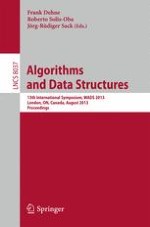This book constitutes the refereed proceedings of the 13th Algorithms and Data Structures Symposium, WADS 2013, held in London, ON, Canada, August 2013. The Algorithms and Data Structures Symposium - WADS (formerly "Workshop on Algorithms and Data Structures") is intended as a forum for researchers in the area of design and analysis of algorithms and data structures. The 44 revised full papers presented in this volume were carefully reviewed and selected from 139 submissions. The papers present original research on algorithms and data structures in all areas, including bioinformatics, combinatorics, computational geometry, databases, graphics, and parallel and distributed computing.
